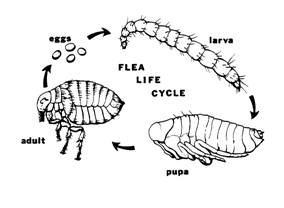防治原则
1.清除孳生地 宜在平时结合灭鼠、防鼠进行,包括清除鼠窝、堵塞鼠洞、堵塞鼠洞,清扫禽畜棚圈、室内暗角等,并用各种杀虫剂杀灭残留的成蚤及其幼虫。
2.灭蚤防蚤 药物敌百虫、敌敌畏等喷洒杀蚤有效。同时,注意对狗、猫等家畜的管理,如定期用药液给狗、猫洗澡。在鼠疫流行时应采取紧急灭蚤措施并加强个人防护。
Identification
There are over 2,000 described species of fleas in the world. The most common domestic flea is the cat flea. The dog flea appears similar to the cat flea, but is rare in the United States . The stick tight flea can become a problem if pets frequent areas associated with poultry.
Eggs are oval, and smooth (Fig. 1.-upper left). They are tiny (0.5mm), but visible to the naked eye. Their white color may prevent them from being seen on lightly- colored fabric.
Small wormlike larvae (1.5-5 mm in length) hatch from the eggs (Fig. 1.-upper right). They are also visible to the naked eye. They are eyeless, legless and sparsely covered with hairs. The larval body is translucent white with a dark-colored gut that can be seen through the skin.
These immature fleas will eventually spin silken cocoons (Fig. 1.-lower right) in which they will develop (pupate) into adult fleas. Cocoons are sticky, attracting dirt and debris. This camouflage may prevent them from being seen.
Adults are about 1-3 mm in length, reddish-brown to black, wingless, and laterally compressed (Fig. 1.-lower left). Their powerful hind legs are well adapted for jumping and running through hair and feathers.
Life Cycle & Biology
Cat flea adults, unlike many other fleas, remain on their host (Fig. 3). Females require a fresh blood meal in order to produce eggs. They can lay up to 1 per hour! The smooth eggs easily fall from the pet onto the carpet, bedding, or lawn. Eggs hatch within 2 days, and the developing larvae feed on dandruff, food particles, and skin flakes found on the floor around them. Adult flea fecal matter consists of relatively undigested blood. This dried blood also falls from the pet and serves as food for the newly hatched larvae.
Fleas prefer to develop in areas protected from rainfall, irrigation, and sunlight, where the relative humidity is at least 75% and the temperature is 70-90ºC. This stage lasts 5-15 days.

Larvae spin silken cocoons within carpet fibers, floor crevices, or protected outdoor areas in which they will develop (pupate) into adult fleas. The cocoons are sticky and easily camouflaged by local debris. Under optimal conditions, new adults are ready to emerge within 2 weeks. They develop faster at higher temperatures, but can remain in their cocoons up to 12 months. Vibrations and/or increase in carbon dioxide stimulate adults to emerge.
Adult fleas are the only growth stage that actually lives on the pet and feeds on fresh blood. They live 4-25 days.
Problems Associated With Fleas
The cat flea is capable of transmitting plague and murine typhus to humans, but reports are rare; its primary importance is its nuisance to humans and pets. Fleas are not picky about their meals; any warm-blooded animal will do. Bites usually cause minor itching, but may be more irritating to those with sensitive skin. Some people and pets suffer from flea allergy dermatitis, lasting up to 5 days and characterized by intense itching, reddening at the bite site, hair loss, and secondary infection. Cat fleas also serve as intermediate hosts of dog tapeworms. These intestinal parasites are transmitted to the pet while grooming via ingestion of an adult flea carrying a tapeworm cyst. Fleas are infected by ingestion of cysts during their larval stage. The parasite segments resemble small pieces of rice and may be discovered around the anal region of your pet.
Detection and Monitoring
Detection is as simple as seeing fleas on your pet, noticing your pet scratching, or flea bites around your ankles. Perhaps there are small black pieces of dirt covering your pet's bedding, or perhaps you've noticed tapeworm segments near or on your pet. The black dirt is the adult flea feces left behind to serve as food for larvae, and tapeworms are acquired by the animal's ingestion of fleas. Another tale tail sign is the appearance of pearly-white eggs on flat surfaces occupied by the pet. Eggs become particularly apparent when contrasted on dark-colored surfaces. Soft, liquid-filled flea eggs can be easily distinguished from sand grains by simply pressing them.
Monitoring is more difficult than simple detection. Fleas reproduce rapidly (one female can produce up to one egg per hour throughout her 4-week adult life), so if you spot one flea there are probably more. Shuffling around you home in white socks looking for fleas jumping onto the socks can help monitor hot spots for flea infestations. This information can help direct control efforts.
If you got flea infestation, please call professional pest control company for help. |
